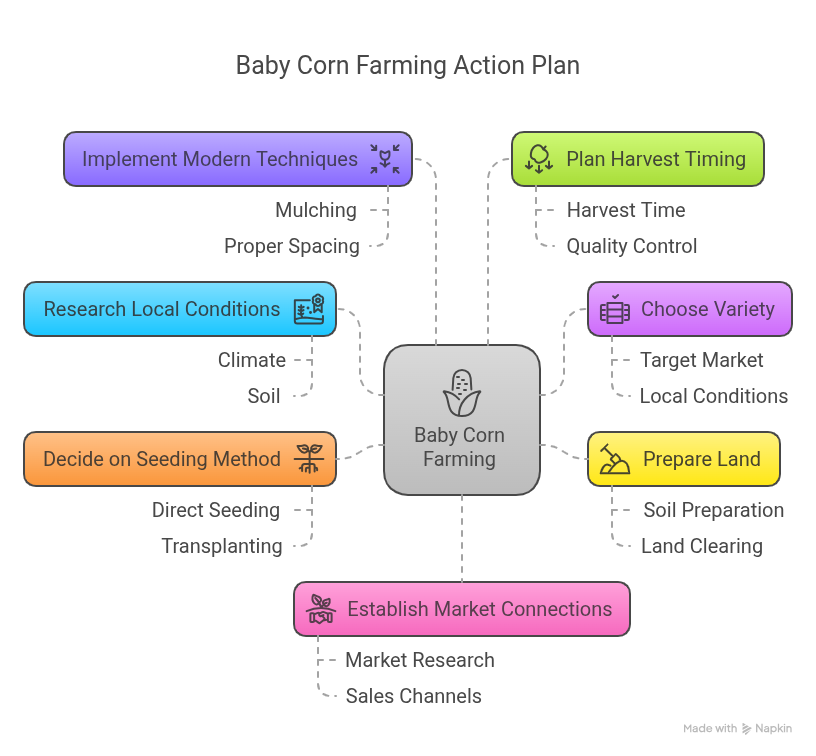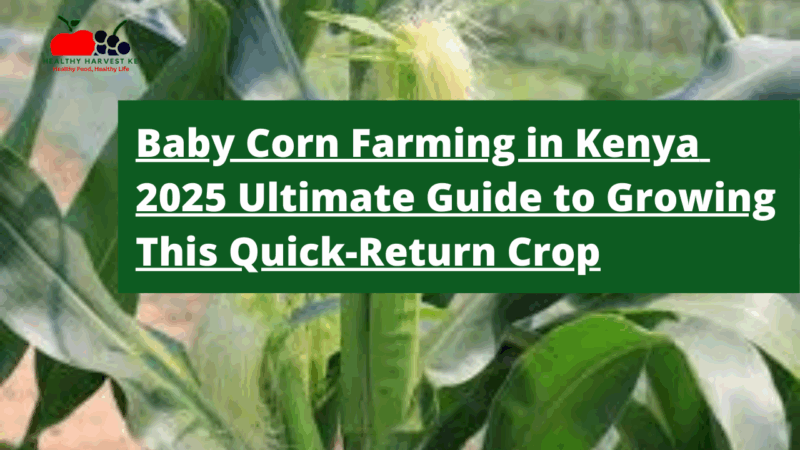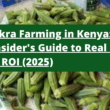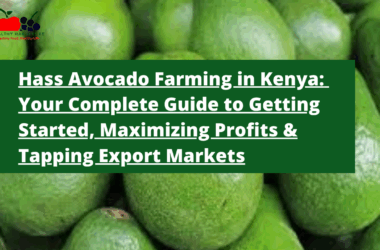Ever spotted those cute little corn cobs in your stir-fry and wondered where they come from? Turns out Kenya’s becoming a hotspot for these mini marvels. Baby corn farming in Kenya has blown up recently – transitioning from just an export thing to showing up more and more on local plates.
If you’re thinking about diving into agriculture with a crop that won’t make you wait half a year for returns, baby corn might be your perfect match. Let’s break down everything you need to know about this 45-60 day wonder crop.
What Exactly Is Baby Corn, Anyway?
Baby corn isn’t some miniature corn variety – it’s actually regular corn harvested super early. You’re picking those ears when they’re still babies (hence the name), usually when they’re about 5-10 cm long and 8-16 mm thick at the base.
Unlike regular maize where you’re waiting for those kernels to develop, with baby corn you’re harvesting when the silk first appears, before the pollination party even starts. This early harvest is what gives baby corn its delicate flavor and crisp texture.
Why Baby Corn Farming Makes Sense for Kenyan Farmers
Kenya’s baby corn game has been steadily climbing. Back in 2014, Kenyan farmers were growing about 567 hectares of baby corn, producing around 4,784 metric tons worth about Ksh. 10 million. Fast forward to 2021, and production jumped to 73,681 metric tons valued at Ksh. 42 million, then further to 121,810 metric tons valued at Ksh. 97,504,132.
Here’s why it’s catching on:
- Quick returns: Unlike most crops, you’re harvesting in just 45-60 days
- Multiple harvests: You can get 2-3 harvests from a single planting
- Dual markets: Sell locally or tap into the established export channels
- Lower risk: The short growing period means less exposure to prolonged weather events
Even with this growth, baby corn farming in Kenya is still finding its feet. There’s tons of room for expansion, especially as research improves cultivation techniques.

The Best Baby Corn Varieties for Kenyan Conditions
Not all baby corn varieties perform the same in Kenya’s diverse growing regions. Here are some popular options that Kenyan farmers are having success with:
| Variety | Key Features | Harvest Time | Yield Potential |
|---|---|---|---|
| SG18 F1 | Good conical cobs, excellent color, 2-3 cobs per plant | 52-59 days | 1.3-3.8 tons/hectare (dehusked) |
| Thai Gold | Popular for export markets | 45-55 days | Varies by conditions |
| PAN 14 | Responds well to transplanting at 200 GDD | 50-60 days | Higher with proper mulching |
| Extra Sweet | Sweeter flavor profile | 45-55 days | Varies by conditions |
| Kandy Corn | Good adaptability | 48-58 days | Varies by conditions |
Each variety has its sweet spot in terms of growing conditions. The SG18 F1 has been particularly successful, producing those perfect conical cobs that export markets go crazy for.
Setting Up Your Baby Corn Farm: The Basics
Soil and Climate Requirements
Baby corn isn’t super picky, but it does have some preferences:
- Warm temperatures (think Kenya’s mid-altitude zones)
- Well-drained, fertile soil
- pH between 6.0 and 7.5
- Plenty of sunlight
- Regular water supply
The crop needs consistent nitrogen, phosphorus, and potassium – the holy trinity of plant nutrients. If your soil is lacking, you’ll need to supplement.
Land Preparation That Sets You Up for Success
Getting your soil ready for baby corn isn’t rocket science, but it does need some attention. Here’s the playbook:
- Plow early to break up the soil structure
- Get aggressive with weed removal – these little corn plants don’t like competition
- Harrow until you’ve got nice, fine tilth
- Mix in about 12.5 tons of well-decomposed manure a month before planting
This prep creates the perfect launching pad for your baby corn seeds or seedlings.
Advanced Growing Techniques That Boost Your Yields
Want to take your baby corn game to the next level? These modern techniques are changing the game for Kenyan farmers:
Transplanting vs. Direct Seeding
Research shows that transplanting seedlings, rather than direct seeding, offers several advantages:
- Less vulnerability to pests and diseases in the crucial early stages
- Better control over spacing for optimal yields
- Shorter overall growing season
- Higher seedling survival rates
The sweet spot for transplanting seems to be around 200 Growing Degree Days (GDD), especially for varieties like PAN 14.
The Mulching Magic
Using colored plastic mulches has shown some seriously impressive results:
- Black mulch: Moderates soil temperature and suppresses weeds like a champ
- Transparent mulch: Boosts soil warming and can increase yields, especially when combined with transplanting at 200 GDD
- All mulches: Help preserve soil moisture and enhance nutrient availability
The research is clear – transplanting PAN 14 at 200 GDD under transparent mulch produces the best cob yields both in greenhouses and open fields.
Understanding Growing Degree Days
This might sound technical, but it’s actually a super useful concept for timing your baby corn production. GDD are basically a measure of heat accumulation that helps you predict:
- When to plant
- When your corn will flower
- The perfect harvest window
- Intervals between key growth stages
Instead of just counting calendar days, tracking GDD gives you a more precise way to manage your crop through the seasons.
Harvesting: Timing Is Everything
Get the timing wrong, and you’ve missed your window for premium baby corn. Here’s how to nail it:
- Harvest between 45-60 days after planting
- Look for ears that are 5-10 cm long and 8-16 mm in diameter
- For SG18 F1, expect first harvest around 52-59 days after planting
Each plant typically gives you 2-3 cobs, and you’ll want to harvest when the silks are just emerging. Wait too long, and your baby corn starts developing kernels – dropping it from premium to standard grade (or worse).
Where Baby Corn Is Thriving in Kenya
Baby corn production isn’t spread evenly across Kenya. Four counties dominate the scene, accounting for a whopping 94% of national production:
- Makueni
- Kirinyaga
- Machakos
- Laikipia
These regions hit the sweet spot of climate, soil, and market access that makes baby corn production particularly viable.

Market Opportunities: Local and Beyond
While baby corn started as an export crop, it’s increasingly finding its way onto local dinner tables. That said, the export market remains significant, with Kenya joining Zimbabwe, Zambia, and South Africa as key African exporters.
The major importing countries include:
- European nations (Denmark, Netherlands, France, UK, Germany)
- United States
- Middle Eastern countries (Bahrain and Qatar)
This dual-market approach gives you flexibility – you can sell locally when prices are good, or tap into premium export markets when the opportunity arises.
Getting Started: Your Baby Corn Action Plan
If you’re convinced that baby corn farming might be your next move, here’s a step-by-step action plan:
- Research your local conditions: Make sure your area has suitable climate and soil
- Choose your variety: Based on your target market and local conditions
- Prepare your land: Remember, good preparation sets the foundation
- Decide on direct seeding or transplanting: Consider your resources and timing
- Implement modern techniques: Mulching and proper spacing will maximize your yields
- Plan your harvest timing carefully: This makes or breaks your product quality
- Establish market connections: Before you plant, know where you’ll sell

The Bottom Line on Baby Corn Farming in Kenya
Baby corn farming in Kenya offers a compelling opportunity for farmers looking for quicker returns and diversification. With its 45-60 day growing period, established export channels, and increasing local popularity, it checks a lot of boxes.
The crop is still in its growth phase in Kenya, with plenty of room for expansion and improvement through modern techniques. For farmers willing to master the specific growing requirements and harvest timing, baby corn represents a promising addition to Kenya’s agricultural landscape.
Have you tried growing baby corn or considered adding it to your farm? Drop a comment below – I’d love to hear about your experience or answer any questions you might have about getting started.
Frequently Asked Questions About Baby Corn Farming in Kenya
How much does it cost to start a baby corn farm in Kenya?
The startup costs vary depending on scale, but for a one-acre baby corn farm, you’ll need about Ksh 30,000-50,000. This covers land preparation, seeds, basic inputs like fertilizer, and labor costs. If you’re incorporating advanced techniques like mulching, add another Ksh 10,000-15,000 to your budget.
Is baby corn farming profitable in Kenya?
Yes, with proper management, baby corn farming can be quite profitable. A well-managed acre can yield 3-4 tons of baby corn, which at current market rates (approximately Ksh 80-120 per kg) can generate Ksh 240,000-480,000 per season. With 2-3 potential harvests per year and relatively low input costs, the profit margins are attractive compared to many other crops.
Can I grow baby corn in my backyard or is it only for commercial farming?
Baby corn is perfect for backyard farming! Its compact size and quick harvest cycle make it ideal for home gardens. Even with just a few square meters, you can produce enough baby corn for your family with some extra to share or sell locally. Use the same principles as larger farms, just scaled down.
How much water does baby corn need?
Baby corn needs consistent moisture but isn’t as thirsty as many other crops. In Kenya’s conditions, irrigation of about 5-7mm per day during dry spells is sufficient. The crop is most sensitive to water stress during the silking stage. Mulching significantly reduces water requirements by minimizing evaporation.
Can baby corn and regular maize be planted together?
While technically possible, it’s not recommended to plant baby corn and regular maize together. Cross-pollination can affect quality, and the different harvest times make management complicated. If you want to grow both, maintain a distance of at least 200 meters between plots or stagger planting times to avoid simultaneous flowering.
What are the main pests and diseases affecting baby corn in Kenya?
The main pests include fall armyworm, stalk borers, and aphids. Common diseases are maize streak virus and gray leaf spot. Since the crop cycle is short, pest and disease pressure is generally less severe than with regular maize. Early monitoring and appropriate pest management practices can minimize these challenges.
How do I store harvested baby corn?
Baby corn has a short shelf life. For the fresh market, keep harvested cobs in cool, humid conditions (around 10°C, 95% humidity) for up to a week. For longer storage, blanching and freezing is effective. For export markets, rapid cooling and proper packaging are essential to maintain quality during transportation.
Is organic baby corn farming feasible in Kenya?
Yes, organic baby corn farming is not only feasible but can command premium prices in both local and export markets. It requires more attention to soil health, natural pest management, and organic inputs, but the short growing cycle makes organic production relatively manageable compared to longer-season crops.
How do I access export markets for my baby corn?
Start by ensuring your production meets international standards for quality and safety. Connect with existing exporters in Kenya who can handle logistics, or join a farmers’ cooperative that already has export channels. Certification (like GlobalGAP) is often required for European markets. The Kenya Export Promotion and Branding Agency can provide guidance on export requirements and opportunities.










